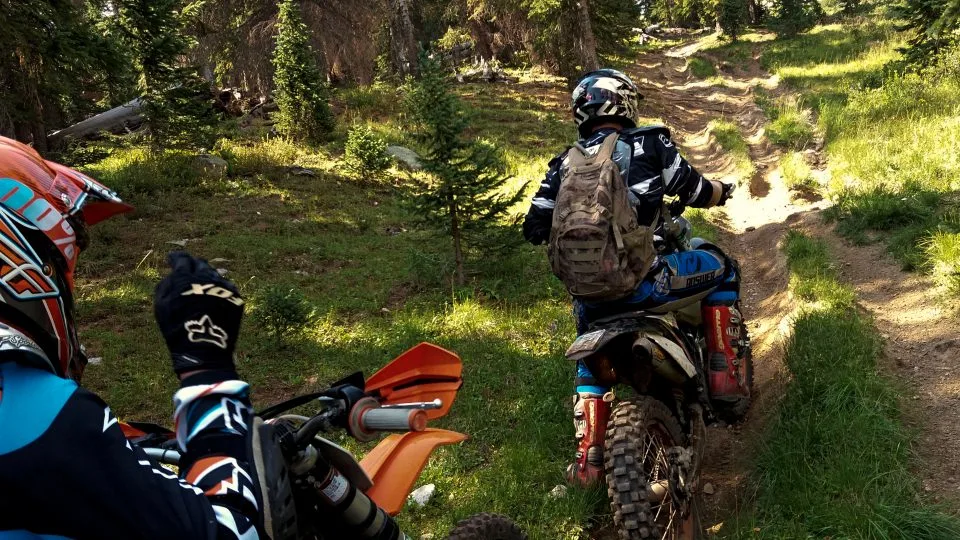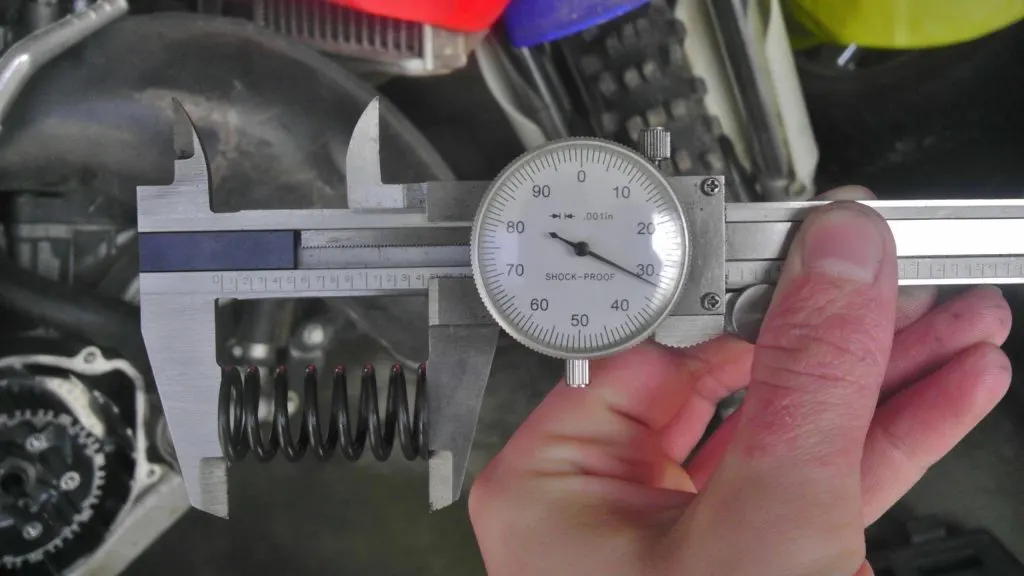Is your dirt bike clutch slipping? How do you know when it's slipping?
If you think you might have clutch problems, then this article is for you. We'll look at the symptoms of a slipping clutch, what causes it to slip, and how to fix it.

How To Tell If My Dirt Bike Clutch Is Slipping
A slipping clutch usually has obvious symptoms, but it depends on how bad it's slipping.
The most common symptoms of a dirt bike clutch slipping are:
- Clutch doesn’t fully engage
- Lack of power on top-end
- Feels like it hits a false neutral when accelerating
- Overheating
- Burnt clutch smell
How Does A Dirt Bike Clutch Work?
A dirt bike clutch has two kinds of plates. One set is “fiber” plates and the other set is simply metal disks.
When the clutch is engaged, both the fiber plate and metal disk press against each other and they rotate the countershaft, which rotates the chain and the wheel to make the dirt bike move. Disengaging the clutch separates the metal disks from the fiber plates so that it doesn't spin the countershaft.

What Does It Mean When The Clutch Is Slipping?
A slipping clutch is when the fiber plates and metal disks don’t spin together when you try to accelerate. This is because they aren’t fully contacting each other or the fiber plates can’t hold the pressure of the spinning metal disks.
For more info on how a clutch works read this article.
What Causes Dirt Bike Clutch To Slip?
The most common causes of dirt bike clutch slippage are worn clutch fiber plates, clutch cable out of adjustment, or an incorrectly installed clutch assembly.
How Do You Fix A Slipping Clutch On A Dirt Bike?
To fix a slipping clutch, first check the cable adjustment. The clutch lever should have a very small amount of "play" or wiggle. If the clutch is properly adjusted and it's still slipping, then the fiber plates are probably worn.
How Do You Adjust A Dirt Bike Clutch Cable?
Your dirt bike should have two adjustment points on the cable assembly. The easiest and first one to adjust is at the clutch perch assembly.
Most clutch perches have a larger locking nut that holds the adjuster screw. Loosen the nut and adjust the screw that the clutch cable goes thru.
The amount of slack should be minimal but visible. You should be able to pull the clutch lever in a fraction of an inch before it starts to actually pull the cable, which disengages the clutch.
How Do I Know If My Clutch Cable Is Stretched?
The adjuster screw should have at least 3 threads into the perch. If there’s less than 3, then you need to move to the lower adjuster next to the clutch arm on the engine case.
If there's no adjustment left on either end of the clutch cable to get the proper play, then the cable is too far stretched and needs to be replaced.
How Do You Know If You Need A New Clutch Cable?
A cable that is stretched too far needs to be replaced with a new one. A cable that is frayed at all should be replaced as well.
It's usually near the end of the cable that you start seeing strands of the metal cable detaching from the rest of the cable.
Once it starts fraying, the cable will only get weaker and eventually break, leaving you without a usable clutch.
How Do You Know When Your Clutch Needs Adjusting?
Anytime your clutch is slipping or dragging means it's time for an adjustment. Cables stretch over time, so excess slack in the clutch lever should be adjusted out as well.
How Do You Adjust Hydraulic Clutch?
A hydraulic clutch is self-adjusting as far as clutch disengagement goes. This is one of the reasons why many riders prefer hydraulic over a cable clutch.
The preload can be adjusted, however, if your clutch perch has an adjuster bolt.
The preload adjuster is great for tuning the distance from the handlebar to the clutch lever for your finger length. Just be sure to not turn it too far in or else the clutch will always be slipping because it can't fully engage.
How Do I Know If My Dirt Bike Clutch Is Bad?
If you can't adjust the clutch externally and it's still slipping, there's a good chance that it's worn out and needs to be replaced. A visual inspection of the plates will confirm this.
How Do You Check A Clutch?
Removing the clutch plates and disks will let you physically inspect each one. Measuring the thickness of the fiber plates will tell you if they're within spec. Refer to your manual for those specs.
Worn metal disks will be discolored when they are worn out and got overheated. It will usually show as a blue, purple, or black color, as opposed to silver when new. Overheating the clutch can also cause the disks to warp.
Why Is My Dirt Bike Clutch Hard To Pull In?
A clutch that is hard to pull in can be due to a few reasons. Cable bind, a dry cable and stiff clutch springs are the most common reasons.
How Can I Make My Clutch Easier To Pull?
The cable may be binding, so first check the routing of the cable to make sure all the bends are smooth. It's easy to kink a cable when working on your bike. This can happen if you recently removed the gas tank.
Did You Use Lube?
The next thing to do is lube the cable. Lubing your cables is a simple maintenance task, but it's easy to forget. A dry cable will cause more friction in the tube, so it requires more force to move it and disengage the clutch.
WD40 can be sprayed in the clutch perch open end, but a cable lubricant with a motion pro cable lubing tool works much better.
You want the lube to get through the entire cable tube for better performance. Pull the clutch lever in to help work the lube down the cable.
A regularly lubed cable will also make it last longer due to reduced friction and wear.
Stiff Clutch Springs Can Hurt
Some dirt bikes naturally have a stiffer clutch pull. This is true for a lot of high performance motocross bikes because they need a heavy duty clutch to contain that power and not allow it to slip.

The aftermarket offers heavy duty clutch springs for some dirt bikes. Stiffer clutch springs will automatically make your clutch lever harder to pull.
Do NOT install stiff clutch springs unless you are modifying the engine to the point that the stock clutch can't handle the extra power.
There's no need to go with "heavy duty clutch springs" on 99% of stock dirt bikes out there.
If the engine is stock and the clutch is slipping then use the tips listed above to fix it.
How To Prevent Your Clutch From Slipping
There’s a number of things you can do to help prevent the clutch from slipping. Clutch slippage creates unnecessary heat in the engine, makes it harder to ride, and simply wears parts out quicker.
You can make your clutch last longer by doing these things:
- Make sure there’s enough oil in the engine/transmission (some 4 strokes separate engine oil from tranny oil)
- Use a good oil that is meant for a wet clutch
- Change the oil when it’s dirty
- Keep the clutch properly adjusted
- Use the engine for power and not the clutch
- Learn better clutch control
By using these simple tips listed, your clutch will last much longer and save you time and money.
Do You Need To Use Clutch When Shifting A Dirt Bike?
Mastering clutch control takes a lot of seat time. Learning basic techniques is important so you get started on the right track. Shifting gears is one way we riders use the clutch…
Or is it? Is there more than one way to shift?
How to become a safe and confident trail rider
Learning proper clutch control is just the beginning to riding with confidence and control off-road. You must also learn proper riding technique, balance (true balance and not just riding faster to stay on the bike), and how to get the most traction to be a safe and confident rider.
I want to show you how to get started learning with proper riding techniques to give you more control quickly. Click here to get started now.

